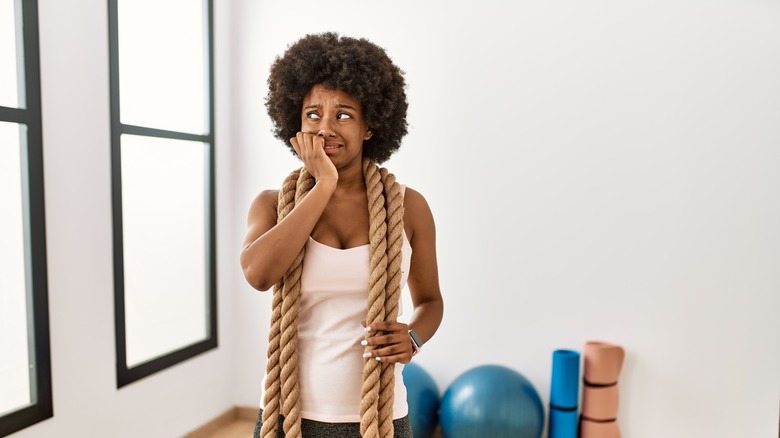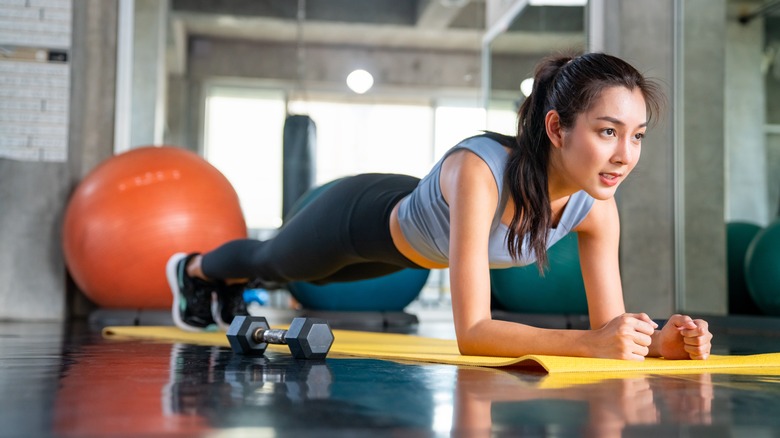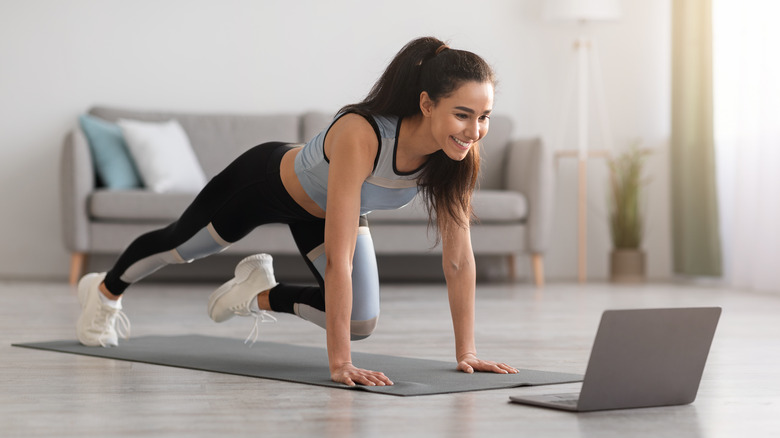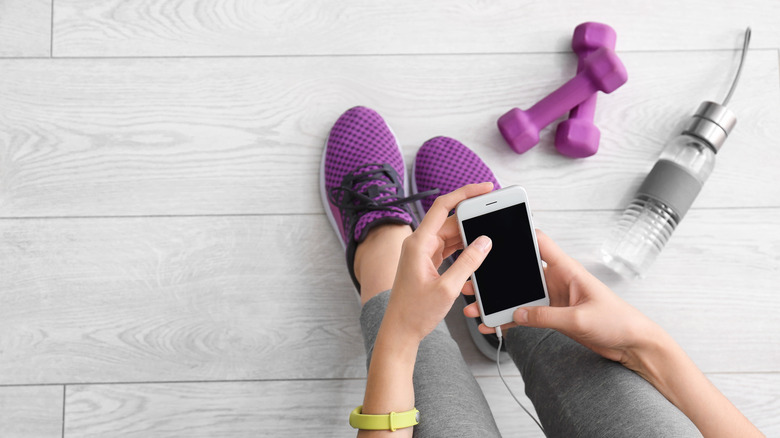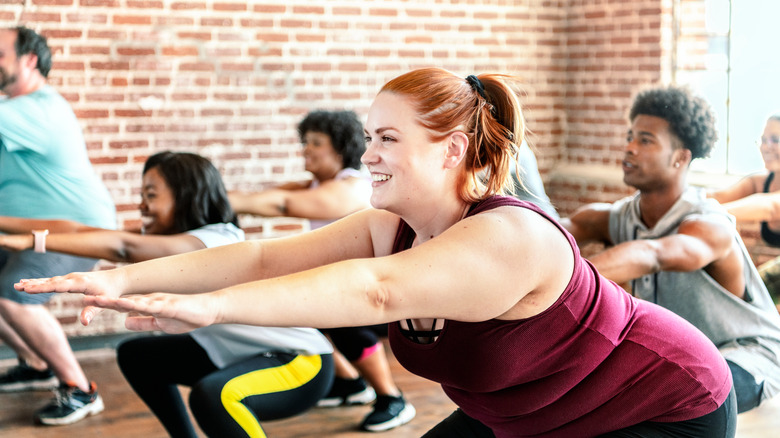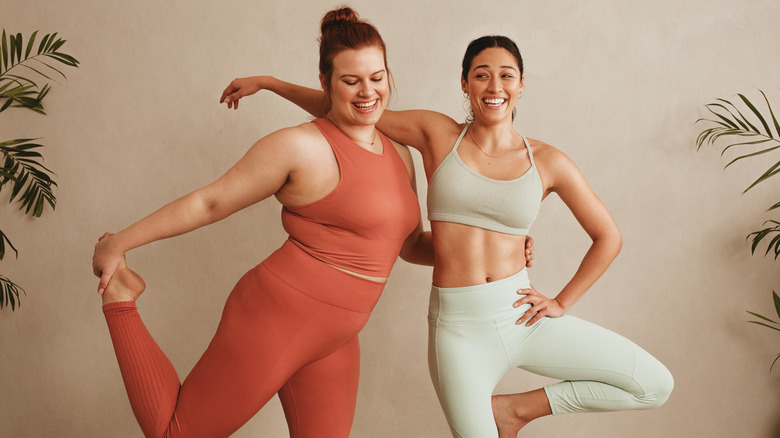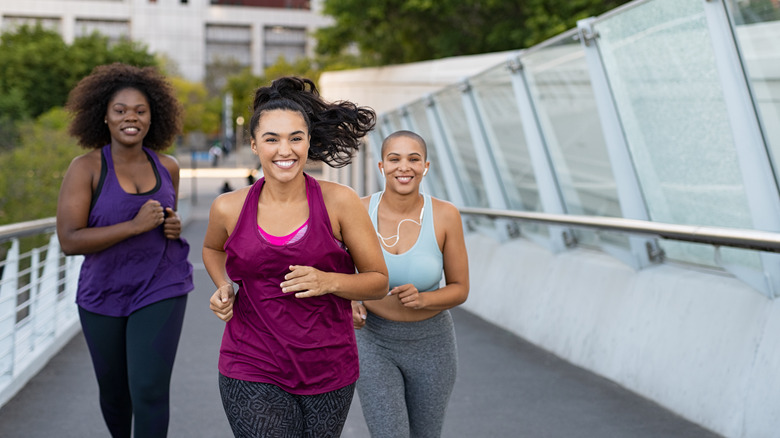How To Defeat 'Gymtimidation' Once And For All
According to science, forming a habit can take anywhere from 18 to 254 days. Making a behavior automatic to our daily routine takes roughly two months, about 66 days (via Healthline).
From learning to eat your vegetables to reducing screen time, it takes an adjustment period to form new healthy habits in your lifestyle. Some often take more time than others, depending on how difficult they are or how acclimated we are to our unhealthy habits. Taking a daily multivitamin, for example, is probably easier to repeat compared to going to sleep early every night.
Another healthy habit that many struggle with? Going to the gym on a consistent basis. However, simply forgetting to do so isn't the only reason that people don't show up for their workouts. The fear of what will happen at the gym prevents some from committing to what they said they would do. This results from "gymtimidation," a phenomenon that plagues people from exercising freely at the gym.
What is gymtimidation?
Seemingly coined around 2014, gymtimidation is the anxiety felt by people at the gym, causing them to be uncomfortable working out, according to Women's Health. The intimidation is commonly felt by women, for a variety of reasons. While some are worried by the weight room and appearing clueless and out of shape, others feel petrified by stares from men and the thought of being naked in the locker room.
Dignity Health confirms that gymtimidation revolves around the apprehension of being watched and judged by more experienced gym-goers for being unsure of how to exercise properly, not knowing what to do with certain gym equipment, and looking "unfit."
This fear of being potential voyeur bait for judgemental gym buffs gets in the way of leading a healthy lifestyle that a gymtimidation sufferer has committed to. Experiencing anxiety in the gym often causes one to exert less effort during workouts or training. It can even prevent others from not showing up to the gym entirely. So what can be done to get rid of gymtimidation?
Practice your moves at home
A major part of gymtimidation is the fear of looking confused or unhealthy. This can manifest by getting out of breath after five minutes on the elliptical or not getting all the movements correctly while doing Pilates. While none of these things are anything to be ashamed of, getting accustomed to a workout at home may save you a bit of embarrassment in public. With the continued practice of a few short at-home workouts, you'll get accustomed to the exercises you plan on doing at the gym, allowing your movements to be more fluid without tiring out as quickly.
Building stamina at home before you commit to going to the gym every week dissolves the fear of tiring out quickly or being lost during a workout. Doing an online workout can also open you up to a variety of exercises to help you find something that's perfect for you. While there are workout classes that come with a fee, YouTube is a great source for free workouts. Good Housekeeping recommends channels like Chloe Ting and Blogilates for consistent workouts that help sculpt and strengthen the body.
Go in with a plan
With a vast amount of treadmills, bench presses, squat racks, and other machines, walking into a gym for the first time is often an overwhelming experience. Rather than stumbling through the unending maze of workout equipment with no sense of direction, make a plan and stick with it. Before stepping foot into the gym, Harvard Medical School recommends creating a workout plan based on your needs and goals.
If you plan on staying at the gym for one hour, think about the things you want to work on that day and split it into chunks. Every good workout starts with getting the heart pumping, so you can include cardio every time you work out. Afterward, assess the areas that you want to work on. If you want to strengthen and tone your muscles, hit the weight room and then use the rowing machine or StairMaster.
When you're focused on hitting your goals, your focus on what other gym-goers may be thinking will fade away. While it's good to stick to your plan, not every machine you want to use will be available. Don't be afraid to have a backup plan or ask an employee what else you can do for your workout.
Take a beginner's class
If you're not the type of person to try and figure out how to make an individualized workout plan, check if your local gym offers any beginner's workout classes. Many gyms have a host of specialized workout classes, from pilates to Zumba, designed precisely for people who are new to exercising.
Shape sings the praises of group workout classes, reporting that people who partake in the classes experience more increases in their physical, mental, and emotional quality of life when up against people who exercise alone. They also have lower rates of stress in comparison to people who don't attend classes.
Being in a group environment is often more motivating than working out alone. This is thanks to the high that comes from being a part of and contributing to a team. When someone feels like they're offering morale to a group they're included in, it encourages them to take on more challenges and be consistent (via the Association for Psychological Science).
Go with a friend
If workout classes aren't for you — due to budget, time, or other factors — try going to the gym with a friend. Having someone that can keep you accountable, and vice versa, will help you reach your goals more easily. After all, you're not just working out for yourself but for someone else, too.
The CDC agrees that having a gym buddy is beneficial, seeing that it can encourage you to be more consistent with your workouts and keep you motivated. They can also help you to go outside your comfort zone, pushing you to try new workouts.
Going to the gym with a friend cuts through the awkward feeling of thinking that you're being observed by others or looking clueless. It's a bit less lonely when you have someone with you that can either help you or out or look just as awkward on you. Chances are, you'll be so focused on the fun a bit of friendly competition brings that you'll focus less on other external things (via Intermountain Healthcare).
Choose an inclusive gym
While social awkwardness and anxiety are two very real things, the discomfort they bring often hinges on our imaginations running wild, creating false realities and dangers that are not actually present. Yet, discomfort and danger can often be a reality for marginalized people working out in gyms.
This can often be a contributor to gymtimidation. Despite being knowledgeable about what you're doing, the threat of being mansplained to or feeling uncomfortable when you're the only person of color can lead you to avoid the gym completely. According to Healthline, this has led to a rise in niche and inclusive gyms.
Going to women-only gyms, attending workout classes led by queer people, or being held for those with disabilities, may allow you to feel more comfortable without your identity being a barrier to your right to exercise. If you're not able to find inclusive gyms in your area, search social media for independent workout groups geared towards creating an inclusive environment or motivate your friends to exercise with you.
Invest in workout clothes
If all else fails, trick yourself into being motivated by dressing up for the gym. Rather than wearing a ratty T-shirt and old shirts, spring for higher-quality leggings, sports bras, and shorts. A new workout wardrobe doesn't have to cost half your budget. There are many affordable places to get new workout clothes, such as ASOS or Old Navy.
The saying "dress for the life you want" isn't just limited to the workplace. When you look good, your determination and confidence increase, motivating you to become more consistent with your workouts (via Harper's Bazaar). Outside of aesthetic purposes, good quality workout clothes also serve a purpose.
They last longer and help to wick sweat away, getting rid of any uncomfortableness that may cause you to leave a workout early, says Endeavor Athletic. A great gym outfit is also ideal for exercising outside. They stand the test of time against the weather, regulating your body temperature by giving you a bit of ventilation.
